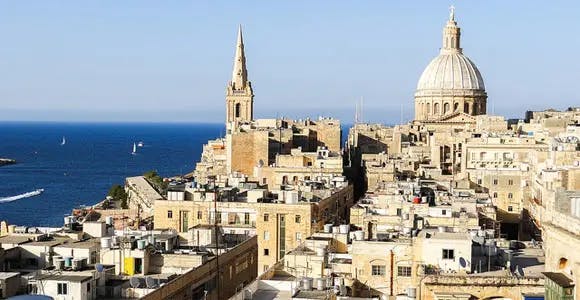By Kathleen Evans
Desirable weather is often among the top five considerations for potential expats when choosing where they would like to settle overseas. Many people we hear from are tired of cold weather and shoveling snow. If you google the warmest place in Europe, your results will point to Valletta, Malta, with an annual average daily temperature of 72°F.
Malta is an archipelago located in the center of the Mediterranean Sea, with Sicily, Italy to the north, and North Africa to the south. The archipelago consists of three main islands, Malta (Malta or Malte), Gozo (Ghawdex), and Comino (Kemmuna), as well as some uninhabited minor islands.
The climate, in general, is sub-tropical Mediterranean, offering cool and rainy winters, a mild spring and fall, and hot summer. And for those of you tired of shoveling snow, the good news is that it doesn’t snow at all in Malta.
Regional Differences
You’ll find little regional difference in weather patterns or temperatures on the two main islands of Malta and Gozo. Malta is just 17 Miles long and nine miles wide, with a total area of 95 square miles. Gozo is even smaller at just 26 square miles. Therefore, the weather forecast for Valletta, the capital, will likely be accurate for all of Malta. Well, as accurate as weather forecasters can be!
The winds are predominantly northwest, as the islands are situated in the Mediterranean’s westerly trade wind zone. The island of Gozo, just north of Malta tends to be slightly cooler, due to the NW winds and less development, but the temperature difference is not that discernable.
Average Temperatures
In Malta, the average temperature ranges from 54.5°F in February to 81.5°F in August. These are based on the average monthly recorded temperatures of the last three decades.
Winter (December to February) is mild by EU standards, and the daily temperature range doesn’t vary much. During these months, sunny periods alternate with periods of inclement weather—rain and wind.
Bone-chilling cold days are rare, with cool winter days seeing highs of 48 to 50°F. On the coldest nights of the year, the temperature can drop to 39 to 41°F. The temperature almost never drops below freezing: On occasion, the airport recorded low temps at 34 to 36°F in the coldest winters. And the last time Malta saw an extremely rare dusting of snow, in January 1962, the temperatures dropped to 29°F.
In spring, the temperature gradually rises. The rains become less frequent, and as early as late April, they become rare. Sometimes, the Maltese archipelago can be affected by the North African Sirocco winds. These are hot, dry winds blowing from the Saharan desert, often accompanied by dust or sand. Typically, it’s more frequent in spring and autumn. When this weather pattern occurs, the temperatures will rise by several degrees.
Summer (June to August) is hot and sunny on the Maltese islands. Even when the breezes blow, humidity can make the heat uncomfortable for some. At this time of year, the typical wind from Africa can bring very hot, albeit brief, periods in which the temperature can reach, or even exceed 104°F.
With the increase in global warming and climate change, these unbearably hot temperature spikes are becoming more commonplace, with highs recorded up to 111°F in August 1999. Fortunately, air conditioning is customary in Maltese homes. Plus, the islands are surrounded by the Mediterranean Sea—an excellent place to cool off on those hot summer days.
In the fall, temperatures are initially summer-like and then gradually decrease. The first weather disturbances typically arrive at the end of September, accompanied by much-anticipated thunderstorms. The temperature is still very pleasant in October, with highs around 77°F.
Rainfall
Rainfall in Malta is scarce, so much so that Valletta is the sunniest capital in Europe—average annual rainfall totals 23.5 inches or 600 millimeters. Malta’s rains follow the typical Mediterranean pattern, so they’re concentrated from October to March, while uncommon in the other months. In the summertime, it rarely ever rains, and average precipitation numbers record just 58 days of rain.
Hurricanes and Natural Disasters
According to the World Risk Report, Malta is the world’s second-safest country regarding natural disasters (following Qatar). The annual report tracks and ranks catastrophic risks for 180 countries on factors like extreme weather, disaster management capabilities, vulnerability, and ability to adapt.
Winter and early spring months are punctuated by rain, strong winds, and occasional flooding. Nonetheless, you can still expect to see sunshine for a few hours nearly every day. Tropical storms and hurricanes around or near the island are extremely rare, thanks to natural geographic protection, sheltered by continental Europe to the north and Africa to the south.
There have been earthquakes in the region (Italy and Greece and shifting plates in the sea), but not in Malta. The islands have felt mild tremors, but no damage or deaths. That being said, erratic weather with climate change doesn’t rule out a future tsunami or hurricane-type event in the Mediterranean. The EU government has stressed Malta to remain prepared for such weather disaster possibilities.
Outdoor Activities
With the mild Mediterranean weather and limited amounts of rain, the Maltese islands are perfect nearly year-round for outdoor activities.
Scuba diving is one of the top activities for those visiting the islands. Malta has over 100 dive sites with a fantastic variety of shipwreck sites at different depth levels, as well as reefs. Cave diving is also popular.
With the winds and the perfect blue skies, sailing is also an excellent opportunity to relax on the open seas. Malta has several sailing clubs, so even if you can’t afford the cost of owning and maintaining a sailboat, you can enjoy the benefits of sailing without ownership.
Surrounded by water, Malta, Gozo, and Comino offer fantastic swimming experiences—from golden sandy beaches, to sea pools carved out of rock. It’s also popular to join or buy a day pass for a pool club. Typically located with a sea view, these pool clubs offer restaurants, cocktail service, and a DJ—creating a fantastic social experience all while relaxing in a swimming pool.
Other prevailing water sports include paddleboarding, kayaking, boating, jet skiing, and snorkeling.
If you’re not much of a water person, the islands offer great hikes once you get out of the city areas. With breathtaking sea-view cliffs and an entire cave system, you can spend many hours exploring the rugged limestone terrain.
Pickleball has made its way to Malta, and this fast-growing sport is a great way to spend time outdoors. There are bocce clubs (Italian lawn bowling) if you’re an old-world traditionalist. The Royal Malta Golf Club offers associate memberships at a fraction of what it costs in North America or the UK. Here, besides golf, you can also take advantage of their tennis courts or enjoy socializing at the clubhouse.
Clothing and Gear
Although the islands don’t have a huge climate variation like northern EU, Malta does have seasons. In the winter, you’ll want sweaters, jackets, a raincoat, an umbrella, or even a puffer or quilted jacket for cold nights. While traditional Maltese homes have heat, they’re built to keep cool during the hot summers, so they tend to stay chilly. Be sure to have some warm slippers.
You’ll need light cotton or breathable, wicking clothing in the summer and early fall: sundresses, shorts, flip flops, and sandals. If you spend a lot of time outdoors, you’ll need plenty of sunscreen, a sun shirt, and a hat. You may need a light jacket, sweatshirt, or wrap for cooler evenings. Plus, you’ll want to invest in a pair of good walking shoes, as the island towns are best set up for walking—on hilly, uneven terrain and pavement.
Malta by day is casual—especially with all the digital nomads and tourists. However, Maltese locals enjoy dressing up a bit and looking smart, made clear by all the designer clothing shops in Sliema. It’s advised to have a diversified wardrobe so you are ready for any occasion or weather event.
Abundant sunshine, mild Mediterranean weather, a low risk of natural disasters, and the tremendous availability of outdoor activities help make Malta an EU favorite for retirement.
Malta International Airport, in Luqa, is the official weather record keeper. You can follow it here for up-to-date weather reporting.








